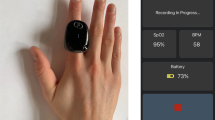Abstract
Background
It is yet unknown if the ApneaGraph200 system can replace the Polysomnography system (PSG), which is now the gold standard for obstructive sleep apnea (OSA) diagnosis. We performed a meta-analysis to evaluate the difference in apnea hypopnea index and lowest oxygen saturation levels between the AG200 system and PSG system.
Methods
Utilizing PubMed, Elsevier, Wanfang, and China National Knowledge Internet (CNKI), a thorough literature search was carried out. Eligible studies contrasting the AG200 system and the PSG system were found by two separate researchers. Review Manager (version 5.3) was adopted for data synthesis.
Results
The meta-analysis A pooled the comparison of AHI between the AG and PSG groups, and included seven studies involving a total of 419 participants, which revealed that there was a significant difference in AHI between the above two diagnostic methods (standard mean difference (SMD) = − 0.19, 95% confidence interval (CI) = − 0.32 to − 0.05, P = 0.008). As a supplementary, meta-analysis B pooled the comparison of lowest oxygen saturation between the AG and PSG groups and included five studies involving a total of 224 participants. It revealed that there was no significant difference between the AG group and the PSG group (SMD = 0.09, 95% CI − 0.24 to 0.43, P = 0.58).
Conclusion
The ApneaGraph200 system can be used for the initial screening of OSA patients, but it is not a complete alternative to polysomnography for the diagnosis and severity of the OSA condition.





Similar content being viewed by others
Availability of data and materials
All data generated or analyzed in this study are included in this published article.
Abbreviations
- AHI:
-
Apnea–hypopnea index
- BMI:
-
Body mass index
- CI:
-
Confidence interval
- OSA:
-
Obstructive sleep apnea
- PSG:
-
Polysomnography
- AG:
-
ApneaGraph200
- DISE:
-
Drug-induced sleep endoscopy
References
Bradley TD, Phillipson EA (1985) Pathogenesis and pathophysiology of the obstructive sleep apnea syndrome. Med Clin N Am 69:1169–1185
Peppard PE, Young T, Barnet JH, Palta M, Hagen EW, Hla KM (2013) Increased prevalence of sleep-disordered breathing in adults. Am J Epidemiol 177:1006–1014
Bahammam A, Delaive K, Ronald J, Manfreda J, Roos L, Kryger MH (1999) Health care utilization in males with obstructive sleep apnea syndrome two years after diagnosis and treatment. Sleep 22:740–747
Kapur VK, Auckley DH, Chowdhuri S, Kuhlmann DC, Mehra R, Ramar K, Harrod CG (2017) Clinical practice guideline for diagnostic testing for adult obstructive sleep apnea: an American Academy of sleep medicine clinical practice guideline. J Clin Sleep Med 13:479–504
Veasey SC, Rosen IM (2019) Obstructive sleep apnea in adults. N Engl J Med 380:1442–1449
Ferber R, Millman R, Coppola M, Fleetham J, Murray CF, Iber C, McCall WV, Nino-Murcia G, Pressman M, Sanders M (1994) Portable recording in the assessment of obstructive sleep apnea. ASDA standards of practice. Sleep 17:378–392
Collop NA (2008) Portable monitoring for the diagnosis of obstructive sleep apnea. Curr Opin Pulm Med 14:525–529
Rama AN, Tekwani SH, Kushida CA (2002) Sites of obstruction in obstructive sleep apnea. Chest 122:1139–1147
Launois SH, Feroah TR, Campbell WN, Issa FG, Morrison D, Whitelaw WA, Isono S, Remmers JE (1993) Site of pharyngeal narrowing predicts outcome of surgery for obstructive sleep apnea. Am Rev Respir Dis 147:182–189
Singh A, Al-Reefy H, Hewitt R, Kotecha B (2008) Evaluation of ApneaGraph in the diagnosis of sleep-related breathing disorders. Eur Arch Otorhinolaryngol 265:1489–1494
Faber CE, Grymer L, Hilberg O, Norregaard O (2002) Flextube reflectometry and pressure-recordings for level diagnosis in obstructive sleep apnoea. Rhinology 40:203–210
Rollheim J, Tvinnereim M, Sitek J, Osnes T (2001) Repeatability of sites of sleep-induced upper airway obstruction. A 2-night study based on recordings of airway pressure and flow. Eur Arch Otorhinolaryngol 258:259–264
Tvinnereim M, Cole P, Haight JS, Hoffstein V (1995) Diagnostic airway pressure recording in sleep apnea syndrome. Acta Otolaryngol 115:449–454
Fu Z, Zhao C, He Y, Yang H (2012) Significance of AG in OSAHS operation treatment guidance and evaluation of postoperative efficacy. Lin Chung Er Bi Yan Hou Tou Jing Wai Ke Za Zhi 26:1116–1118
Karaloglu F, Kemaloglu YK, Yilmaz M, Ulukavak Ciftci T, Ciftci B, Bakkal FK (2017) Comparison of full-night and ambulatory polysomnography with ApneaGraph in the subjects with obstructive sleep apnea syndrome. Eur Arch Otorhinolaryngol 274:189–195
Olafsson TA, Steinsvik EA, Bachmann-Harildstad G, Hrubos-Strom H (2022) A validation study of an esophageal probe-based polygraph against polysomnography in obstructive sleep apnea. Sleep Breath 26:575–584
Shen P, Li WY, Huo H, Yang DH (2007) Comparison of diagnosis and localization methods in obstructive sleep apnea syndrome: apneagraph vs polysomnography and apneagraph vs endoscopy. Zhonghua Er Bi Yan Hou Tou Jing Wai Ke Za Zhi 42:612–618
Yu L, Sun J, Chen X, Yuan W, Liu Y, Zhou C, Sun B, Wen Y (2014) AG200 and polysomnography in patients with obstructive sleep apnea-hypopnea syndrome. Lin Chung Er Bi Yan Hou Tou Jing Wai Ke Za Zhi 28:1691–1693
Yu R, Li W, Huo H, Shen P, Tian X (2011) Short daytime ApneaGraph for initial case selection of obstructive sleep apnea-hypopnea syndrome before surgery. Eur Arch Otorhinolaryngol 268:1663–1669
Higgins JP, Thompson SG (2002) Quantifying heterogeneity in a meta-analysis. Stat Med 21:1539–1558
Mantel N, Haenszel W (1959) Statistical aspects of the analysis of data from retrospective studies of disease. J Natl Cancer Inst 22:719–748
Higgins JP, Thompson SG, Deeks JJ, Altman DG (2003) Measuring inconsistency in meta-analyses. BMJ 327:557–560
DerSimonian R, Laird N (1986) Meta-analysis in clinical trials. Control Clin Trials 7:177–188
Egger M, Davey Smith G, Schneider M, Minder C (1997) Bias in meta-analysis detected by a simple, graphical test. BMJ 315:629–634
Begg CB, Mazumdar M (1994) Operating characteristics of a rank correlation test for publication bias. Biometrics 50:1088–1101
Duval S, Tweedie R (2000) Trim and fill: a simple funnel-plot-based method of testing and adjusting for publication bias in meta-analysis. Biometrics 56:455–463
Petrisor BA, Keating J, Schemitsch E (2006) Grading the evidence: levels of evidence and grades of recommendation. Injury 37:321–327
McNicholas WT, Bonsigore MR (2007) Management Committee of ECAB: Sleep apnoea as an independent risk factor for cardiovascular disease: current evidence, basic mechanisms and research priorities. Eur Respir J 29:156–178
Elwood P, Hack M, Pickering J, Hughes J, Gallacher J (2006) Sleep disturbance, stroke, and heart disease events: evidence from the Caerphilly cohort. J Epidemiol Community Health 60:69–73
Kezirian EJ, Hohenhorst W, de Vries N (2011) Drug-induced sleep endoscopy: the VOTE classification. Eur Arch Otorhinolaryngol 268:1233–1236
Huang XX, Chen HH, Tang J, Lu J, Deng YQ, Li XP (2017) Comparative study of VOTE classification in obstructive sleep apnea hypopnea syndrome patients between awake and sleep state. Lin Chung Er Bi Yan Hou Tou Jing Wai Ke Za Zhi 31:918–924
Joy J, Bhat N, Bhandarkar P (2021) Assessment of site, degree and pattern of airway obstruction in patients with moderate to severe obstructive sleep apnoea (OSA) using drug induced sleep endoscopy (DISE) and its association with awake fibreoptic evaluation and polysomnography parameters. Indian J Otolaryngol Head Neck Surg 73:315–320
Ciscar MA, Juan G, Martinez V, Ramon M, Lloret T, Minguez J, Armengot M, Marin J, Basterra J (2001) Magnetic resonance imaging of the pharynx in OSA patients and healthy subjects. Eur Respir J 17:79–86
Achar P, Kumar BN (2014) Can apneagraphy change our approach in management of snoring and sleep apnoea? Indian J Otolaryngol Head Neck Surg 66:110–114
Funding
This manuscript was not funded.
Author information
Authors and Affiliations
Contributions
YC, designed study, collected data, analyzed data, wrote article; XN, designed study, revised article.
Corresponding author
Ethics declarations
Conflict of interest
The authors declare that they have no competing interests.
Ethical approval and consent to participate
Not applicable.
Consent for publication
Not applicable.
Additional information
Publisher's Note
Springer Nature remains neutral with regard to jurisdictional claims in published maps and institutional affiliations.
Rights and permissions
Springer Nature or its licensor (e.g. a society or other partner) holds exclusive rights to this article under a publishing agreement with the author(s) or other rightsholder(s); author self-archiving of the accepted manuscript version of this article is solely governed by the terms of such publishing agreement and applicable law.
About this article
Cite this article
Chen, Y., Niu, X. Can polysomnography be replaced by ApneaGraph200 for OSA diagnosis? A protocol for systematic review and meta-analysis. Eur Arch Otorhinolaryngol 280, 2065–2072 (2023). https://doi.org/10.1007/s00405-022-07815-8
Received:
Accepted:
Published:
Issue Date:
DOI: https://doi.org/10.1007/s00405-022-07815-8




